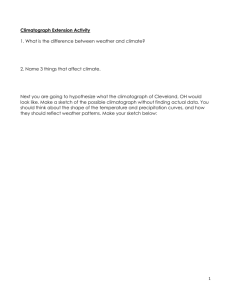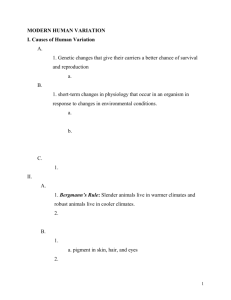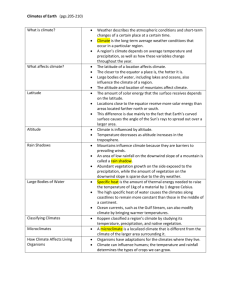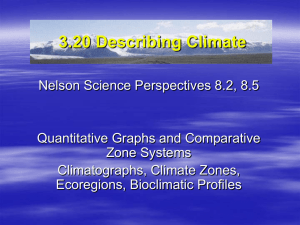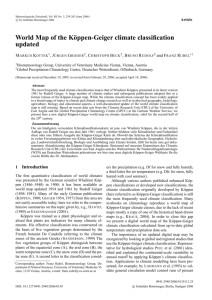GES 100 Exam 3 Review
advertisement
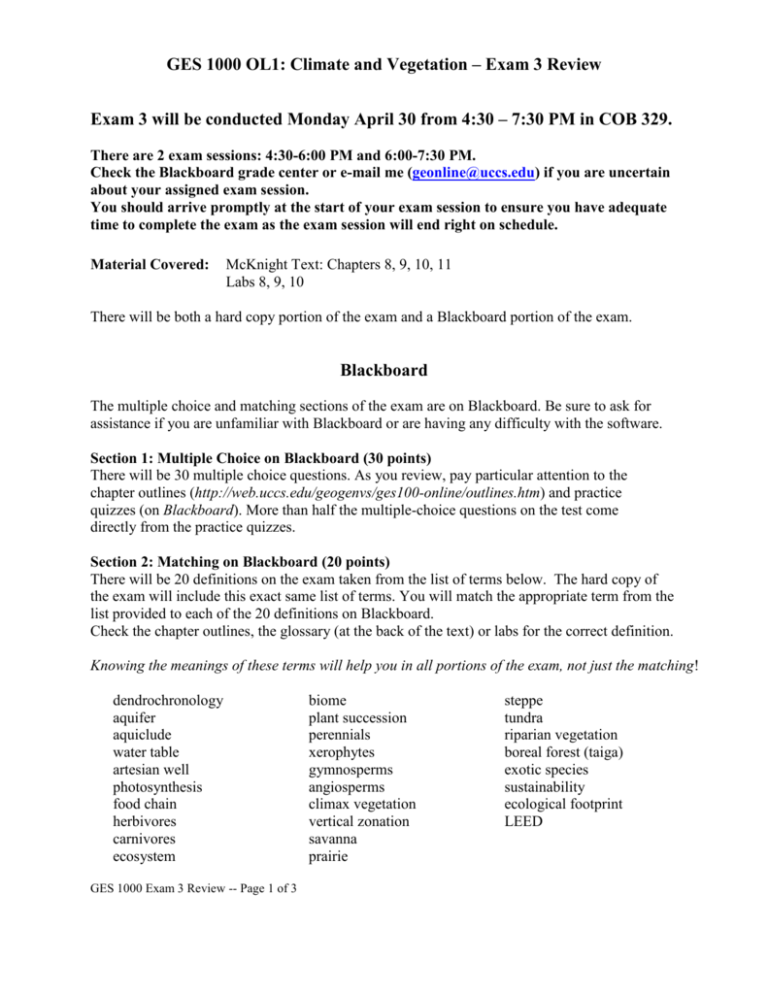
GES 1000 OL1: Climate and Vegetation – Exam 3 Review Exam 3 will be conducted Monday April 30 from 4:30 – 7:30 PM in COB 329. There are 2 exam sessions: 4:30-6:00 PM and 6:00-7:30 PM. Check the Blackboard grade center or e-mail me (geonline@uccs.edu) if you are uncertain about your assigned exam session. You should arrive promptly at the start of your exam session to ensure you have adequate time to complete the exam as the exam session will end right on schedule. Material Covered: McKnight Text: Chapters 8, 9, 10, 11 Labs 8, 9, 10 There will be both a hard copy portion of the exam and a Blackboard portion of the exam. Blackboard The multiple choice and matching sections of the exam are on Blackboard. Be sure to ask for assistance if you are unfamiliar with Blackboard or are having any difficulty with the software. Section 1: Multiple Choice on Blackboard (30 points) There will be 30 multiple choice questions. As you review, pay particular attention to the chapter outlines (http://web.uccs.edu/geogenvs/ges100-online/outlines.htm) and practice quizzes (on Blackboard). More than half the multiple-choice questions on the test come directly from the practice quizzes. Section 2: Matching on Blackboard (20 points) There will be 20 definitions on the exam taken from the list of terms below. The hard copy of the exam will include this exact same list of terms. You will match the appropriate term from the list provided to each of the 20 definitions on Blackboard. Check the chapter outlines, the glossary (at the back of the text) or labs for the correct definition. Knowing the meanings of these terms will help you in all portions of the exam, not just the matching! dendrochronology aquifer aquiclude water table artesian well photosynthesis food chain herbivores carnivores ecosystem GES 1000 Exam 3 Review -- Page 1 of 3 biome plant succession perennials xerophytes gymnosperms angiosperms climax vegetation vertical zonation savanna prairie steppe tundra riparian vegetation boreal forest (taiga) exotic species sustainability ecological footprint LEED Section 3: Maps and Graphs Items to which you should pay particular attention: 1. Climate Classification – The majority of the hard copy portion of exam 3 will consist of classifying climates using the Köppen classification system. You do not need to memorize the Köppen guidelines or the dry climate boundary graphs; they will be provided (They will be identical to pp. 5 and 6 of Lab 8). a. You should be able to construct a climograph given temperature, precipitation and potential evapotranspiration data. b. You should be able to calculate the annual temperature range of a station. c. Given the general guidelines for Köppen categories, you should be able to determine the Köppen climate class for given stations. Again, you do not need to memorize the Köppen guidelines; they will be provided! d. Based on the data you should be able to determine generally where the station is located - northern v. southern hemisphere; coastal v. continental. 2. Hydrologic Cycle a. You should understand and be able to explain the hydrologic cycle and associated terms. 3. Global Biomes You should be familiar with the major biomes discussed in Chapter 11 of the textbook. Given a list of the major biomes, you should be able to match biome types with their descriptions and general spatial distribution. Pay particular attention to those located in the United States. 4. Sustainability a. You should understand the concept of sustainability and the ecological footprint. b. You should have a general understanding of variation in national ecological footprints, but you do not need to memorize the specific ecological footprint numbers! c. You should have some understanding of sustainability issues: housing choices; consumption choices; etc. HINT: As you study for exam 3, you should concentrate your efforts on Chapters 8 and 11 (climate classification and major biomes). Only certain portions of Chapter 10 will be covered in the exam: The following sections of Chapter 10 will not be covered on exam 3: The Oxygen Cycle The Nitrogen Cycle Other Mineral Cycles The Search for a Meaningful Classification Scheme. Basic Concepts from this Unit You Should Understand 1. Classifying Climates Based on the Köppen System of Climate Classification Determining the Köppen climate classification: The Köppen climate system uses capital letters to designate categories by latitude that range from A at the equator to E at the poles plus an H for highlands. All the categories are based on temperature except B which is based on precipitation as well. Classifying Climates: The first step you should take when you are classifying climatic data is compare POTET and PRECIP. If PRECIP>POTET, it is not a B climate; proceed to the criteria for A, C, and D climates to determine how to classify the climate. Start with the general statements at the beginning of each description to determine the major classification: A, C or D. In all B climates potential evapotranspiration exceeds precipitation; however, not all climates in which POTET>PRECIP are B climates! IF POTET>PRECIP you must determine if it is a B climate using the dry climate boundary graphs. Choose the appropriate graph based on seasonal precipitation concentration and determine where the station data falls on the graph. If it falls outside the B range; proceed to criteria for A, C and D climates. After you have determined the major classification, look at the criteria to determine the second letter of the classification which reflects precipitation. For the third letter (temperature: a, b, c, or d) always proceed through the criteria from warmest (“a”) to coolest (“d”) to determine the correct classification. Constructing climographs: (1) mean monthly temperature: plot with a solid line graph using the temperatures on the scale on the right vertical axis (2) mean monthly precipitation: plot with a bar graph using the precipitation values on the scale on the left vertical axis (3) potential evapotranspiration: plot with a dotted line graph using the precipitation values on the scale on the left vertical axis Computing the annual temperature range: The annual temperature range is found by subtracting the lowest monthly mean temperature from the highest monthly mean temperature. Determining a station's location: Hemisphere: Stations in the northern hemisphere should have their warmest monthly temperatures in Jun, Jul, and Aug (during our summer) and their coldest in Dec, Jan, and Feb. Those in the southern hemisphere should be just the opposite. Sometimes the differences in equatorial climates are very small. Coastal v. Continental: Coastal locations generally have a smaller temperature range than continental locations at the same latitude. 2. Biomes: A biome is a large, recognizable assemblage of plants and animals in functional interaction with its environment. A biome is usually named on the basis of its dominant vegetation. Often, significant and even predictable relationships exist between the biota of a biome and the associated climate and soil types. 3. Sustainability: In a sustainable world societies consume only as many resources as the earth can produce or renew needs are in line with earth's capacity to produce. The ecological footprint measures in acres/person how much land and water a society or individuals require to produce the resources they consume and to absorb their waste. Developed nations tend to have a much higher footprint than developing nations.



